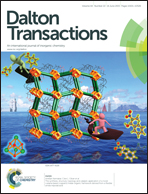Three new luminescent Cd(ii)-MOFs by regulating the tetracarboxylate and auxiliary co-ligands, displaying high sensitivity for Fe3+ in aqueous solution†
Abstract
Three new Cd(II)-MOFs, [Cd(L1)0.5(bpp)] (1), [Cd(L1)0.5(bipy)] (2), and [Cd(L2)0.5(bipy)] (3) [H4Ln = (1,1′:4′,1′′-terphenyl)-2′,x,x′′,5′-tetracarboxylic acid (n = 1, x = 3, and n = 2, x = 4), bpp = 1,3-di(4-pyridyl)propane, and bipy = 2,2′-bipyridine], have been synthesized using Cd(II) ions and isomeric H4Ln ligands in the presence of auxiliary ligands via solvothermal reaction, and have been fully characterized by elemental analysis, FT-IR spectroscopy, powder X-ray diffraction (PXRD), and thermogravimetric analysis (TGA). Complex 1 is a three-dimensional (3D) pillar-layered network built from L14− and bridging bpp co-ligands with a binodal (4,8)-connected gsp2 topology and a symbol of (44·62)(416·612). 2 was successfully synthesized using bipy instead of the bpp ligand used to assemble 1 giving a 2D 4-connected sql net. 3 is a 3D reticular framework with [Cd2(COO)4] SBUs based on L24− ligands, displaying a (4,4)-connected lvt (42·84) topology. X-ray diffraction analysis revealed that the structures of the MOFs can be mediated by the steric effect of the tetracarboxylate and secondary co-ligands. The solid-state luminescence properties of the MOFs were measured carefully by ultraviolet irradiation at room temperature. In particular, 3 exhibited a high sensitivity for Fe3+ in aqueous solutions of mixed metal ions, which makes it a promising crystalline material to be a luminescent probe for Fe3+. Importantly, 3 can keep its original framework and be reused in sensing experiments. The sensing mechanism has also been studied in detail.


 Please wait while we load your content...
Please wait while we load your content...